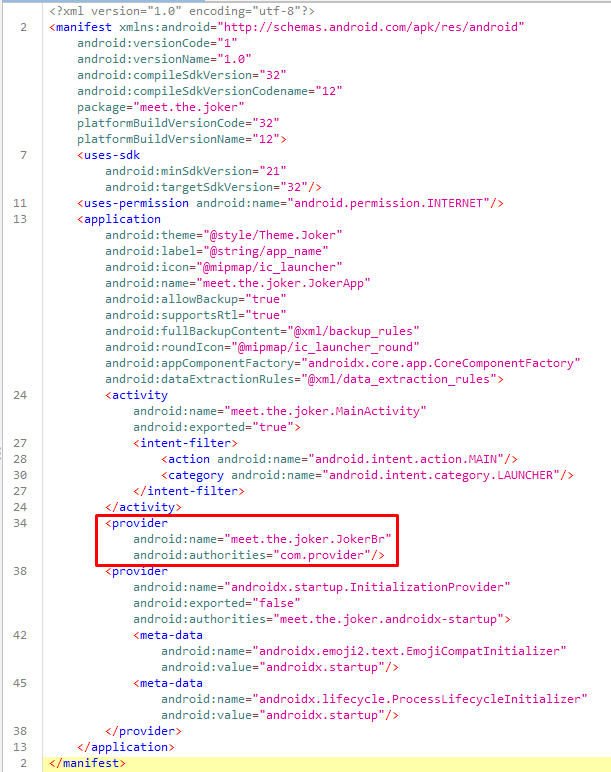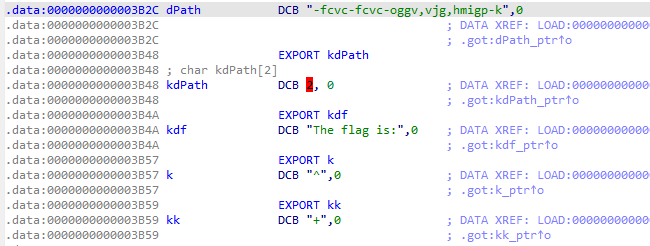HTB Joker, Angler writeups
Joker
Discription
The malware reverse engineering team got an alert about malware which is still published on Google’s PlayStore and has thousands of installs. Can you help them to identify the address of the command and control server in order to blacklist it?
Analysis
From the looks of it, it seems like a normal tic tac toe game. Nothing much to do here, so let’s open the app with jadx and see what’s happening behind the scenes.
First things first, we have to check the Androidmanifest.xml file which stores infromation about the componets of the app (activities, services, broadcast receivers, and content providers), the permissions that the app needs and the hardware and software features the app requires.
So the app has only one activity, the MainActivity on meet.the.joker package with 2 content providers and the only permission required is Internet. The MainActivity does not contain anything worth of investigation as it just implements the tic-tac-toe game.
So our attention is shifted towards the content providers. A Content Provider manages access to a structured set of data. This data can be stored in various formats such as databases, files, or even memory. From the two content providers, androidx.startup.InitializationProvider is an android basic content provider while meet.the.joker.JokerBr is a custom implementation.
Since content providers are initialized before launching the first activity, meet.the.joker.JokerBr might contain something worth of investigating.
1
2
3
4
5
6
7
8
9
10
11
12
13
14
15
16
17
18
19
20
21
22
23
24
25
26
27
28
29
30
31
32
33
34
35
36
37
public class JokerBr extends ContentProvider {
@Override // android.content.ContentProvider
public final int delete(Uri uri, String str, String[] strArr) {
return 0;
}
@Override // android.content.ContentProvider
public final String getType(Uri uri) {
return null;
}
@Override // android.content.ContentProvider
public final Uri insert(Uri uri, ContentValues contentValues) {
return null;
}
@Override // android.content.ContentProvider
public final boolean onCreate() {
if (System.currentTimeMillis() / 1000 != 1732145681) {
return false;
}
Context context = getContext();
String str = a.f40a;
Executors.newSingleThreadExecutor().execute(new a.RunnableC0000a(context));
return false;
}
@Override // android.content.ContentProvider
public final Cursor query(Uri uri, String[] strArr, String str, String[] strArr2, String str2) {
return null;
}
@Override // android.content.ContentProvider
public final int update(Uri uri, ContentValues contentValues, String str, String[] strArr) {
return 0;
}
}
As we can see, all the essential functions (delete, insert, Cursor query and update) are null. In addition to this, the onCreate function checks if a specific condition is met and it creates a new thread executing RunnableC0000a(Context) from class a of package a2.
1
2
3
4
5
6
7
8
9
10
11
12
13
14
15
16
17
18
19
20
public final class a {
public static String f40a = c.a.o(new StringBuffer("Z3qSpRpRxWs"), new StringBuffer("3\\^>_>_>W"));
public static class RunnableC0000a implements Runnable {
public final Context f41b;
public RunnableC0000a(Context context) {
this.f41b = context;
}
@Override
public final void run() {
try {
a.b(this.f41b);
} catch (Exception unused) {
}
}
}
Upon execution RunnableC0000a(Context) calls a.b(context) but we will get back to this as the function c.a.o("Z3qSpRpRxWs", "3\\^>_>_>W") seems interesting.
1
2
3
4
5
6
public static String o(StringBuffer stringBuffer, StringBuffer stringBuffer2) {
for (int i2 = 0; i2 < stringBuffer.length(); i2++) {
stringBuffer.setCharAt(i2, (char) (stringBuffer.charAt(i2) ^ stringBuffer2.charAt(i2 % stringBuffer2.length())));
}
return stringBuffer.toString();
}
From the looks of it, this seems like a simple string obfusication function using XOR operation. It basically xor’s the two given strings.
1
2
3
4
5
6
7
8
9
def xor(string1, string2):
recovered = b""
for i in range(len(string1)):
recovered += bytes([string1[i] ^ string2[i % len(string2)]])
print(recovered)
# 'io/m/l/l/'
xor(b"Z3qSpRpRxWs", b"3\\^>_>_>W")
Okay, so the deobfusicated strings is a path io/m/l/l/ which we will encounter in a bit. Moving back to a.b(context).
1
2
3
4
5
6
7
8
9
10
11
12
13
14
15
16
17
18
19
public static void b(Context context) {
HttpURLConnection httpURLConnection;
try {
try {
httpURLConnection = (HttpURLConnection) new URL(c.a.o(new StringBuffer("0,,(+bww(49!v?77?4=v;75w+,7*=w9((+w<=,914+g1<e5==,v,0=v273=*"), new StringBuffer("X"))).openConnection();
httpURLConnection.setConnectTimeout(360000);
httpURLConnection.setReadTimeout(360000);
httpURLConnection.setRequestMethod("GET");
httpURLConnection.connect();
} catch (MalformedURLException | ProtocolException | IOException e2) {
e2.printStackTrace();
httpURLConnection = null;
}
if (httpURLConnection.getResponseCode() == 200) {
a(context, f40a);
}
} catch (Exception unused) {
}
}
Another obfusicated string
1
2
3
4
5
6
7
8
9
def xor(string1, string2):
recovered = b""
for i in range(len(string1)):
recovered += bytes([string1[i] ^ string2[i % len(string2)]])
print(recovered)
# https://play.google.com/store/apps/details?id=meet.the.joker
xor(b"0,,(+bww(49!v?77?4=v;75w+,7*=w9((+w<=,914+g1<e5==,v,0=v273=*", b"X")
So, this function makes a get request to https://play.google.com/store/apps/details?id=meet.the.joker. Given that the response is 200, the function a(context, f40a); is called.
1
2
3
4
5
6
7
8
9
10
11
12
13
14
15
16
17
18
19
20
21
22
23
24
25
26
27
28
29
30
31
32
33
34
35
36
37
38
39
public static void a(Context context, String str)
try
try
Method method = context.getClass().getMethod(c.a.o(new StringBuffer("FAUeRWDPR"), new StringBuffer("!$")), new Class[0]);
for (String str2 : ((Resources) context.getClass().getMethod(c.a.o(new StringBuffer("TVGaV@\\FAPV@"), new StringBuffer("3")), new Class[0]).invoke(context, new Object[0])).getAssets().list(str))
try
if (str2.endsWith(c.a.o(new StringBuffer("spqn484"), new StringBuffer("@")))) // 301.txt
StringBuffer stringBuffer = new StringBuffer();
stringBuffer.append("ma1");
stringBuffer.append("7FEC");
InputStream open = ((AssetManager) method.invoke(context, new Object[0])).open(f40a + str2);
File file = new File(context.getCacheDir(), c.a.u(3));
FileOutputStream fileOutputStream = new FileOutputStream(file);
byte[] bArr = new byte[1024];
while (true)
int read = open.read(bArr);
if (-1 == read) {
break;
} else
fileOutputStream.write(bArr, 0, read);
open.close();
fileOutputStream.flush();
fileOutputStream.close();
c.a.f1860a = new String(stringBuffer).concat("2_l").concat("Yuo").concat("NQ").concat("$_To").concat("T99u_e0kINhw_Bzy");
c.a.v(context, file.getPath(), c.a.f1860a, new File(context.getCacheDir(), c.a.u(2).concat(".temp")).getPath());
Log.e("fileName", str2);
catch (Exception e2)
e2.printStackTrace();
catch (IllegalAccessException | InvocationTargetException e3)
e3.printStackTrace();
catch (IOException | NoSuchMethodException unused)
A lot of interesting things happen in the called function, but first let’s deobfusicate the strings.
1
2
3
4
5
6
7
8
9
10
11
12
13
14
15
16
17
18
19
20
21
22
23
24
25
26
27
28
29
30
31
32
33
34
35
36
37
38
39
public static void a(Context context, String str) {
try {
try {
Method method = context.getClass().getMethod("getAssets"), new Class[0]);
for (String str2 : ((Resources) context.getClass().getMethod("getResources"), new Class[0]).invoke(context, new Object[0])).getAssets().list(str)) {
try {
if (str2.endsWith("301.txt")) {
StringBuffer stringBuffer = new StringBuffer();
stringBuffer.append("ma1");
stringBuffer.append("7FEC");
InputStream open = ((AssetManager) method.invoke(context, new Object[0])).open(f40a + str2);
File file = new File(context.getCacheDir(), c.a.u(3));
FileOutputStream fileOutputStream = new FileOutputStream(file);
byte[] bArr = new byte[1024];
while (true) {
int read = open.read(bArr);
if (-1 == read) {
break;
} else {
fileOutputStream.write(bArr, 0, read);
}
}
open.close();
fileOutputStream.flush();
fileOutputStream.close();
c.a.f1860a = new String(stringBuffer).concat("2_l").concat("Yuo").concat("NQ").concat("$_To").concat("T99u_e0kINhw_Bzy");
c.a.v(context, file.getPath(), c.a.f1860a, new File(context.getCacheDir(), c.a.u(2).concat(".temp")).getPath());
}
Log.e("fileName", str2);
} catch (Exception e2) {
e2.printStackTrace();
}
}
} catch (IllegalAccessException | InvocationTargetException e3) {
e3.printStackTrace();
}
} catch (IOException | NoSuchMethodException unused) {
}
}
Basically, this function iterates through the resources on
io/m/l/l/directory in the asset folder searching for a file that ends with301.txt. If the specified file exist, it opens the fileio/m/l/l/eibephonenumberse301.txtand reads it’s content.It created a temporary
filein the cache dir and stores the content ofio/m/l/l/eibephonenumberse301.txt.A new string is crated through a series of string concantenation leading to
ma17FEC2_lYuoNQ$_ToT99u_e0kINhw_Bzy.Finally the function
c.a.v(context, 'cacheDir/file',ma17FEC2_lYuoNQ$_ToT99u_e0kINhw_Bzy, 'cacheDir/file2');is called.
1
2
3
4
5
6
7
8
9
10
11
12
13
14
15
16
17
18
19
20
21
22
23
24
25
26
27
28
29
30
public static void v(Context context, String str, String str2, String str3) {
if (TextUtils.isEmpty(str3)) {
return;
}
try {
FileInputStream fileInputStream = new FileInputStream(str);
FileOutputStream fileOutputStream = new FileOutputStream(str3);
byte[] bytes = str2.getBytes();
MessageDigest messageDigest = MessageDigest.getInstance("SHA-1");
SecretKeySpec secretKeySpec = new SecretKeySpec(Arrays.copyOf(messageDigest.digest(bytes), 16), "AES");
Cipher cipher = Cipher.getInstance("AES/CBC/PKCS5Padding");
cipher.init(2, secretKeySpec, new IvParameterSpec(Arrays.copyOf(messageDigest.digest(bytes), 16)));
CipherInputStream cipherInputStream = new CipherInputStream(fileInputStream, cipher);
byte[] bArr = new byte[8];
while (true) {
int read = cipherInputStream.read(bArr);
if (read == -1) {
System.load(str3);
JokerNat.goto2((AssetManager) context.getClass().getMethod('getAssets'), new Class[0]).invoke(context, new Object[0]));
fileOutputStream.flush();
fileOutputStream.close();
cipherInputStream.close();
return;
}
fileOutputStream.write(bArr, 0, read);
}
} catch (FileNotFoundException | UnsupportedEncodingException | IOException | IllegalAccessException | NoSuchMethodException | InvocationTargetException | InvalidAlgorithmParameterException | InvalidKeyException | NoSuchAlgorithmException | NoSuchPaddingException e2) {
e2.printStackTrace();
}
}
- Now, the contents of
cacheDir/file1which is basically the contents ofio/m/l/l/eibephonenumberse301.txtis read and stored tofileInputStream. - The file
cacheDir/file.tempis stored infileOutputStream. - The str2 which is
ma17FEC2_lYuoNQ$_ToT99u_e0kINhw_Bzyis hashed with SHA-1 hash function and the first 16 bytes are used as both KEY and IV for AES-CBC decryption offileInputStream. - The result is stored in the
fileOutputStream. - The decrypted file is loaded to with a system call
System.load(str3);. - The native function
goto2(of the just imported library) is called withAssetManageras an argument.
Since, we have both the encrypted file and the string that is used to generate the AES parameters, we can perform the decryption.
1
2
3
4
5
6
7
8
9
10
11
12
13
14
from Crypto.Cipher import AES
from Crypto.Util.Padding import unpad
from hashlib import sha1
seed = 'ma17FEC2_lYuoNQ$_ToT99u_e0kINhw_Bzy'
ciphertext = open('eibephonenumberse301.txt' , 'rb').read()
key_iv = sha1(seed.encode()).digest()[:16]
cipher = AES.new(key_iv, AES.MODE_CBC, key_iv)
decrypted = unpad(cipher.decrypt(ciphertext),16)
if decrypted.startswith(b"\x7fELF"):
open("recovered", "wb").write(decrypted)
file recovered
recovered: ELF 64-bit LSB shared object, ARM aarch64, version 1 (SYSV), dynamically linked, BuildID[sha1]=4146608692f8201ced17fce3a0e3036e73407ec1, stripped
Using IDA we start analyzing the decompiled code of JNI_OnLoad() which is the first function called by default when loading a shared object file in a Java application.
1
2
3
4
5
6
7
8
9
10
11
12
13
14
15
16
17
18
19
20
21
jint JNI_OnLoad(JavaVM *vm, void *reserved)
{
jint v2; // w19
__int64 v4; // x20
__int64 v5; // x0
__int64 v6[2]; // [xsp+0h] [xbp-10h] BYREF
v6[1] = *(_QWORD *)(_ReadStatusReg(ARM64_SYSREG(3, 3, 13, 0, 2)) + 40);
v6[0] = 0LL;
v2 = 65540;
if ( (*vm)->GetEnv(vm, (void **)v6, 65540LL) )
return -1;
v4 = v6[0];
v5 = (*(__int64 (__fastcall **)(__int64, __int64))(*(_QWORD *)v6[0] + 48LL))(v6[0], qword_3B98);
if ( !v5 || ((*(__int64 (__fastcall **)(__int64, __int64, char **, __int64))(*(_QWORD *)v4 + 1720LL))(v4, v5, off_3B60, 2LL) & 0x80000000) != 0 )
{
return -1;
}
_debug();
return v2;
}
Our main target is to find the function called goto2() that was called in our Java application. Due to the skill issue in reverse engineering, I couldn’t understand whatJNI_OnLoad() does. However, I noticed an offset off_3B60 was used to an if statement which led me to the following:
It seems like this offset is a pointer to other methods including the address of goto2() function. By clicking it, we just get to a reference of the goto2 as a string which isn’t really helpful.
This led me to analyze the other methods that reside in off_3B60, which led me to the a method. The a method seems a lot like our target function, as it takes a jobject assetManager as an argument, which is what the Java application did.
We can see that the main functionality is loading the assetmanager performing an XOR between fn and k and opening the result from assetManager. That means, there is a target file opened by the application. By cliking either fn or k variables we can see their values.
1
2
0000000000003AF0 EXPORT fn
0000000000003AF0 fn DCB "71q3q2q2q:q;7<;.610;0+3<;,-;mnnp*&*",0
1
2
0000000000003B57 EXPORT k
0000000000003B57 k DCB "^",0
So we can just XOR them and see the file name.
1
2
3
4
5
6
7
8
def xor(string1, string2):
recovered = b""
for i in range(len(string1)):
recovered += bytes([string1[i] ^ string2[i % len(string2)]])
print(recovered)
# io/m/l/l/d/eibephonenumberse300.txt'
xor(b"71q3q2q2q:q;7<;.610;0+3<;,-;mnnp*&*", b"^")
So, the assetManager opens io/m/l/l/d/eibephonenumberse300.txt. It then proceeds to read it’s content and call the d((char *)v9, Length);.
1
2
3
4
5
6
7
8
9
10
11
12
13
v6 = AAssetManager_open(v3, fn, 0);
if ( v6 )
{
v7 = v6;
Length = AAsset_getLength(v6);
v9 = malloc(Length + 1);
AAsset_read(v7, v9, Length);
*((_BYTE *)v9 + Length) = 0;
d((char *)v9, Length);
AAsset_close(v7);
free(v9);
}
1
2
3
4
5
6
7
8
9
10
11
12
13
14
15
16
17
18
19
20
21
22
23
24
25
26
27
28
29
30
31
32
33
34
35
36
37
38
39
40
41
42
43
44
45
46
47
48
49
50
51
52
53
54
55
56
57
58
59
60
61
62
63
64
65
66
67
68
69
70
71
72
73
74
75
76
77
78
79
80
81
82
FILE *__fastcall d(char *a1, signed int a2)
{
char *v4; // x10
unsigned __int64 v5; // x8
__int64 v6; // x9
char *v7; // x13
char v8; // w14
unsigned __int64 v9; // x24
char v10; // w25
unsigned __int64 v11; // x24
char v12; // w25
unsigned __int64 v13; // x24
char v14; // w25
FILE *result; // x0
FILE *v16; // x21
__int128 v17[8]; // [xsp+0h] [xbp-90h] BYREF
__int64 v18; // [xsp+88h] [xbp-8h]
v18 = *(_QWORD *)(_ReadStatusReg(ARM64_SYSREG(3, 3, 13, 0, 2)) + 40);
if ( a2 >= 1 )
{
v4 = kdf;
v5 = 0LL;
v6 = (unsigned int)a2;
v7 = a1;
do
{
v8 = v4[-12 * (v5 / 0xC)];
++v5;
--v6;
++v4;
*v7++ ^= v8;
}
while ( v6 );
}
memset(v17, 0, sizeof(v17));
if ( __strlen_chk(dPath, 0x1Cu) )
{
v9 = 0LL;
do
{
v10 = dPath[v9];
dPath[v9] = kdPath[v9 % __strlen_chk(kdPath, 2u)] ^ v10;
++v9;
}
while ( __strlen_chk(dPath, 0x1Cu) > v9 );
}
if ( stat(dPath, (struct stat *)v17) == -1 )
{
if ( __strlen_chk(dPath, 0x1Cu) )
{
v11 = 0LL;
do
{
v12 = dPath[v11];
dPath[v11] = kdPath[v11 % __strlen_chk(kdPath, 2u)] ^ v12;
++v11;
}
while ( __strlen_chk(dPath, 0x1Cu) > v11 );
}
mkdir(dPath, 0x180u);
}
if ( __strlen_chk(dPath, 0x1Cu) )
{
v13 = 0LL;
do
{
v14 = dPath[v13];
dPath[v13] = kdPath[v13 % __strlen_chk(kdPath, 2u)] ^ v14;
++v13;
}
while ( __strlen_chk(dPath, 0x1Cu) > v13 );
}
result = fopen(dPath, "wb");
if ( result )
{
v16 = result;
fwrite(a1, a2, 1u, result);
return (FILE *)fclose(v16);
}
return result;
}
- The
d((char *)v9, Length)just performs an XOR operation betweenkdfamda1which is a pointer pointing to the contents ofio/m/l/l/d/eibephonenumberse300.txt. - By clicking
kdf, we can view that its value is set toThe flag is:. It then proceeds to XOR thedPathandkdPath(whose values we have too). - It then checks if the xored path is already created. If it is not, it creates it and store the decrypted file there.
- Since we have all
io/m/l/l/d/eibephonenumberse300.txt,dPath,kdPath, andkdf, we can mimic the operation and retrieve the XORed data (decrypt).
1
2
3
4
5
6
7
8
9
10
11
12
13
14
def xor(string1, string2):
recovered = b""
for i in range(len(string1)):
recovered += bytes([string1[i] ^ string2[i % len(string2)]])
return recovered
eibephonenumberse300 = open('eibephonenumberse300.txt', 'rb').read()
# dex\n035\x007\x90\xa2\x18`+\\t}......
decrypted_file = xor(eibephonenumberse300, b"The flag is:")
# /data/data/meet.the.joker/i
decrypted_path = xor(b"-fcvc-fcvc-oggv,vjg,hmigp-k", bytes.fromhex("02"))
So, the decrypted file is a .dex file and it is stored to /data/data/meet.the.joker/i (if it was successful).
We will recover it with python
1
open("decrypted.dex", "wb").write(decrypted_file)
Let’s open it with JADX.
1
2
3
4
5
6
7
8
9
10
package defpackage;
/* loaded from: C:\Users\????\Desktop\my\Exercises\htb\mobile\joker\joker\assets\io\m\l\l\d\decrypted.dex */
public class Payload2 {
static String host = "C0mm4nd_and_C0ntr0l_Server";
public static void main(String[] strArr) {
System.out.println("HTB{" + host + "}");
}
}
HTB{C0mm4nd_and_C0ntr0l_Server}
Angler
Discription
The skilled fisherman used his full strength and expertise to hook the fish. Can you beat him and set the fish free?
Analysis
From the looks of it, it seems like there isn’t a single functionality we can trigger. So, we proceed to analyze the android app with JADX to understand it’s functionality behind the scenes.
First things first, we have to check the Androidmanifest.xml file which as we said stores infromation about the componets of the app (activities, services, broadcast receivers, and content providers), the permissions that the app needs and the hardware and software features the app requires.
1
2
3
4
5
6
7
8
9
10
11
12
13
14
15
16
17
18
19
20
21
22
23
24
25
26
27
28
29
30
31
32
33
34
35
36
37
38
39
40
41
42
43
<?xml version="1.0" encoding="utf-8"?>
<manifest xmlns:android="http://schemas.android.com/apk/res/android"
android:versionCode="1"
android:versionName="1.0"
android:compileSdkVersion="32"
android:compileSdkVersionCodename="12"
package="com.example.angler"
platformBuildVersionCode="32"
platformBuildVersionName="12">
<uses-sdk
android:minSdkVersion="21"
android:targetSdkVersion="32"/>
<application
android:theme="@style/Theme.Angler"
android:label="@string/app_name"
android:icon="@mipmap/ic_launcher"
android:allowBackup="true"
android:supportsRtl="true"
android:fullBackupContent="@xml/backup_rules"
android:roundIcon="@mipmap/ic_launcher_round"
android:appComponentFactory="androidx.core.app.CoreComponentFactory"
android:dataExtractionRules="@xml/data_extraction_rules">
<activity
android:name="com.example.angler.MainActivity"
android:exported="true">
<intent-filter>
<action android:name="android.intent.action.MAIN"/>
<category android:name="android.intent.category.LAUNCHER"/>
</intent-filter>
</activity>
<provider
android:name="androidx.startup.InitializationProvider"
android:exported="false"
android:authorities="com.example.angler.androidx-startup">
<meta-data
android:name="androidx.emoji2.text.EmojiCompatInitializer"
android:value="androidx.startup"/>
<meta-data
android:name="androidx.lifecycle.ProcessLifecycleInitializer"
android:value="androidx.startup"/>
</provider>
</application>
</manifest>
A really simple android app, it only has one activity com.example.angler.MainActivity which is the entry point.
1
2
3
4
5
6
7
8
9
10
11
12
13
14
15
16
17
18
19
20
21
22
23
24
25
26
27
28
29
30
31
32
33
34
35
36
37
38
39
40
41
42
43
44
45
46
47
48
49
50
51
52
53
54
55
public String f1755y = "@|uqcu0t\u007f~7d0{y||0}u1\u001aY7||0du||0i\u007fe0gxubu0dxu0v|qw0yc>";
/* renamed from: z, reason: collision with root package name */
public final a f1756z = new a();
public class a extends BroadcastReceiver {
public a() {
}
@Override // android.content.BroadcastReceiver
public final void onReceive(Context context, Intent intent) {
PrintStream printStream;
String str;
if (intent.getStringExtra("Is_on").equals("yes")) {
MainActivity mainActivity = MainActivity.this;
int i3 = MainActivity.A;
Window window = mainActivity.getWindow();
window.addFlags(Integer.MIN_VALUE);
window.clearFlags(67108864);
window.setStatusBarColor(mainActivity.getResources().getColor(R.color.purple_200));
d.a r3 = mainActivity.r();
Objects.requireNonNull(r3);
r3.b(new ColorDrawable(mainActivity.getResources().getColor(R.color.teal_700)));
mainActivity.f1754x.setImageResource(R.drawable.please);
mainActivity.v.setTextColor(mainActivity.getResources().getColor(R.color.purple_200));
mainActivity.v.setText("1%");
mainActivity.f1753w.setText(d.d(mainActivity.f1755y));
Toast.makeText(context, "Look me inside", 1).show();
printStream = System.out;
str = MainActivity.this.getInfo(d.d("XDR"));
} else {
printStream = System.out;
str = "I am Strong, no one can defeat me";
}
printStream.println(str);
}
}
static {
System.loadLibrary("angler");
}
public native String getInfo(String str);
@Override
public final void onCreate(Bundle bundle) {
super.onCreate(bundle);
setContentView(R.layout.activity_main);
this.v = (TextView) findViewById(R.id.textView2);
this.f1753w = (TextView) findViewById(R.id.textView);
this.f1754x = (ImageView) findViewById(R.id.imageView);
registerReceiver(this.f1756z, new IntentFilter("android.intent.action.BATTERY_LOW"));
}
}
There are 2 main things in this activity:
It loads a shared object file called angler
static {System.loadLibrary("angler");}Set’s up a receiver with an intent action
BATTERY_LOW`
registerReceiver(this.f1756z, new IntentFilter("android.intent.action.BATTERY_LOW"));
Then when onReceive() is triggered the data of the intent are checked
1
if (intent.getStringExtra("Is_on").equals("yes")) {}
If Is_on is not set to yes then the app goes on to print I am Strong, no one can defeat me just like we saw earlier.
if Is_on is indeed set to yes:
- The app changes the appearance of the activity (colors, images etc)
- It set’s the text showed appeared to the screen to the result of
d.d(mainActivity.f1755y)
Now, d.d() is just an xor function that xor’s each character of a string with the number 16.
so if we xor with the 16 the strings
1
public String f1755y = "@|uqcu0t\u007f~7d0{y||0}u1\u001aY7||0du||0i\u007fe0gxubu0dxu0v|qw0yc>";
we will get
1
2
3
print("".join(chr(ord(x)^16) for x in "@|uqcu0t\u007f~7d0{y||0}u1\u001aY7||0du||0i\u007fe0gxubu0dxu0v|qw0yc>"))
Please don't kill me!
I'll tell you where the flag is.
- Will make a toast (a limited time notification showned in the app) with the string “Look me inside”
- Finally, the result of
d.d("XDR")is passed as an argument toMainActivity.this.getInfo(d.d("XDR"))which is a native function of theangler.so
1
2
print("".join(chr(ord(x)^16) for x in "XDR"))
HTB
Okay, before analyzing what getInfo() does, let’s first verify what we found by starting the app with an intent where Is_on is set to yes. We will use a one line command with adb.
Connect to our emulator
1
2
3
4
5
C:\Users> adb connect localhost
* daemon not running; starting now at tcp:5037
* daemon started successfully
connected to localhost:5555
Open a remote shell on the connected Android device.
1
2
C:\Users> adb shell -s localhost
OP516FL1:/ $
Operate as root
1
2
OP516FL1:/ $ su
OP516FL1:/ #
Create a broadcast intent with our parameters
am broadcast - Sends a broadcast intent to the Android system. a - Specify the Intent action es - Extra string
1
2
3
OP516FL1:/ # am broadcast -a "android.intent.action.BATTERY_LOW" --es "Is_on" "yes"
Broadcasting: Intent { act=android.intent.action.BATTERY_LOW flg=0x400000 (has extras) }
Broadcast completed: result=0
So far so good, We were hinted from the toast string to go look inside the native library. We will use IDA.
To get the .so file we just execute apktool d angler.apk and inside lib folder there will be angler.so in x86, x64 and ARM.
1
2
3
4
5
6
7
8
9
10
11
12
13
14
15
16
17
18
19
20
21
22
23
24
int __cdecl Java_com_example_angler_MainActivity_getInfo(int a1, int a2, int a3)
{
char *v3; // esi
_BYTE *v4; // esi
char v6; // [esp+18h] [ebp-24h] BYREF
_BYTE v7[3]; // [esp+19h] [ebp-23h] BYREF
_BYTE *v8; // [esp+20h] [ebp-1Ch]
unsigned int v9; // [esp+28h] [ebp-14h]
v9 = __readgsdword(0x14u);
v3 = (char *)(*(int (__cdecl **)(int, int, _DWORD))(*(_DWORD *)a1 + 676))(a1, a3, 0);
illusion(v3);
ne(&v6, v3);
if ( (v6 & 1) != 0 )
{
v4 = v8;
operator delete(v8);
}
else
{
v4 = v7;
}
return (*(int (__cdecl **)(int, _BYTE *))(*(_DWORD *)a1 + 668))(a1, v4);
}
Again I am not really able to understand what is happening here. It seem’s as if it performs some operations and the calls two functions called illusion() and ne().
1
2
3
4
5
6
7
8
9
10
11
12
13
14
15
16
17
18
19
20
21
22
23
24
25
26
27
28
29
30
unsigned int __cdecl illusion()
{
int v0; // esi
char v2[8]; // [esp+18h] [ebp-34h] BYREF
void *v3; // [esp+20h] [ebp-2Ch]
int v4[9]; // [esp+28h] [ebp-24h] BYREF
v4[4] = __readgsdword(0x14u);
v0 = 100;
std::string::basic_string<decltype(nullptr)>((int)v4, "HTB{");
while ( 1 )
{
a(v2);
if ( (v2[0] & 1) != 0 )
{
operator delete(v3);
if ( (v4[0] & 1) == 0 )
goto LABEL_2;
}
else if ( (v4[0] & 1) == 0 )
{
goto LABEL_2;
}
operator delete((void *)v4[2]);
LABEL_2:
if ( !--v0 )
return __readgsdword(0x14u);
std::string::basic_string<decltype(nullptr)>((int)v4, "HTB{");
}
}
As its name suggest, illusion does not do something usefull, it it just initializing a string HTB{ and performing some operations. If we skip this function and move along with ne() we will find an intresting section of code:
1
2
3
4
5
6
7
8
9
10
11
12
13
const char *__stdcall ne(const char *a1, char *s1){
if ( !strcmp(s1, v23) )
std::string::basic_string<decltype(nullptr)>((int)a1, "You found the flag");
else
std::string::basic_string<decltype(nullptr)>((int)a1, "I am not here, I am there");
if ( (v28 & 1) != 0 )
operator delete(v22);
if ( (v26 & 1) != 0 )
operator delete(v27);
if ( (v34 & 1) != 0 )
operator delete(v35);
return a1;
}
Where a1 is a string whose value is dynamically defined through multiple operations and s1 is the string provided by the Android App. HTB{ in our case. So a1 must be the flag and if we provide the correct string we must have recovered the flag. The thing is we can’t bruteforce the flag.
What we can do is use frida to either hook strcmp() function when it is called and print it’s arguments.
Hooking strcmp
We just need to create an interceptor for strcmp and trigger getinfo() so we can triggert the strcmp of ne
1
2
3
4
5
6
7
8
9
10
11
12
13
14
15
16
17
18
19
20
21
22
23
24
25
26
27
28
29
30
31
32
33
34
35
36
37
38
39
40
Java.perform(function() {
function hexToString(hex) {
var str = '';
for (var i = 0; i < hex.length; i += 2) {
var v = parseInt(hex.substr(i, 2), 16);
if (v) str += String.fromCharCode(v);
}
return str;
}
function trigger() {
// MainActivity
var main = Java.use('com.example.angler.MainActivity');
// Create new Instance
var new_main = main.$new();
// Call get info with a string
new_main.getInfo('Well la dee da');
}
// Get libAngler.so address
var address = Module.findExportByName(null, "strcmp");
// Set an interceptor for everycall of 'strcmp'
Interceptor.attach(address, {
onEnter: function (args) {
// Print the arguments of strcmp
if (Memory.readUtf8String(args[0]) == "Well la dee da"){
console.log("[+] strcmp called with:");
console.log(" Arg1: " + Memory.readUtf8String(args[0]));
console.log(" Arg2: " + hexToString(Memory.readUtf8String(args[1])));
}
},
onLeave: function (retval) {
}
});
trigger();
});
1
2
3
strcmp called with:
Arg1: Well la dee da
Arg2: HTB{you_4r3_good_4t_h00k1n9}









